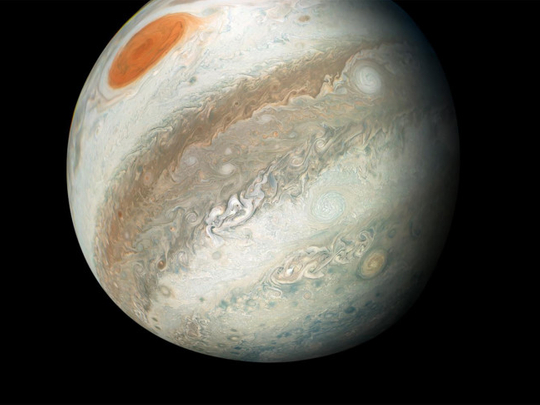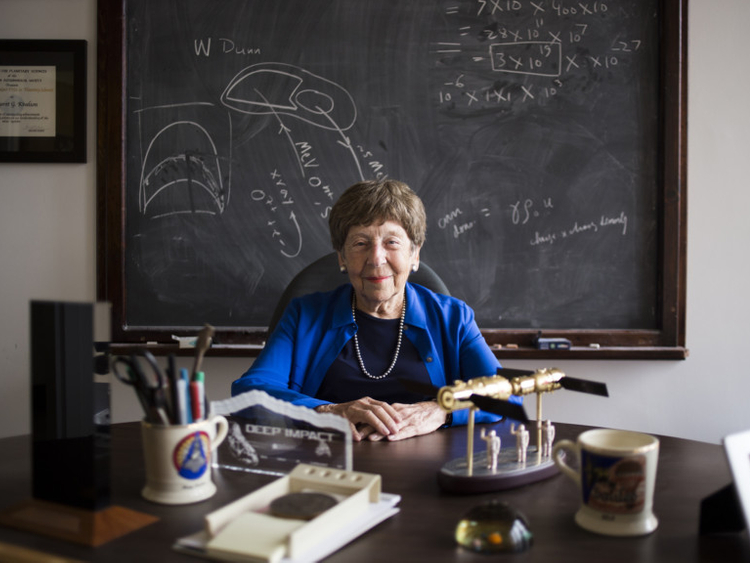
The data was like nothing Margaret Kivelson and her team of physicists ever expected. It was December 1996, and the spacecraft Galileo had just flown by Europa, an icy moon of Jupiter. The readings beamed back to earth suggested a magnetic field emanating from the moon. Europa should not have had a magnetic field, yet there it was — and not even pointed in the right direction. “This is unexpected,” she recalled saying as the weird data rolled in. “And that’s wonderful.”
It would be the most significant of a series of surprises from the Jovian moons. For Kivelson’s team, the mission should not have been this exciting.
She and her colleagues had devised the magnetometer returning the anomalous data. The instrument’s job was to measure Jupiter’s massive magnetic field and any variations caused by its moons. Those findings were likely to interest space physicists, but few others. Kivelson’s instrument was never supposed to change the course of space exploration.
And then it did. Kivelson and her team would soon prove that they had discovered the first subsurface, saltwater ocean on an alien world.
Kivelson, who turned 90 last month, is professor emerita of space physics at the University of California, Los Angeles. For 40 years, she has been an active part of almost every major Nasa voyage beyond the asteroid belt. She has a wry sense of humour, and her modesty belies the magnitude of her scientific achievements.
Her team transformed the way magnetometers are used on space missions, making them an essential tool of discovery. The outer solar system is now a hot zone in the search for habitability.
Most recently, Kivelson has been an investigator working on the plasma instrument for the Europa Clipper, Nasa’s next great voyage to the outer solar system. Scheduled to launch as early as 2022, the spacecraft will study the habitability of Jupiter’s ocean moon. Kivelson’s work will help answer whether life could be there by determining the ocean’s depth and salinity, and the thickness of the ice shell above it.
But the story started with Galileo’s unusual encounters with Jupiter’s moons. Inscrutable Europa, it turned out, had its own way of doing things. “We came up with a lot of wrong ideas,” said Kivelson. Years after the first flyby, however, they found their answer.
Harvard and Hydrogen
Kivelson was born in New York City. Her father was a physician. Her mother was a schoolteacher. Margy, as her friends call her, excelled in mathematics at an early age. “I liked it,” she said. “I thought it was one of the easier subjects, and I knew that opinion was not common.”
She was accepted to Harvard, which formally excluded women, consigning them officially to Radcliffe College — a separate school without a faculty. Harvard professors would walk across the commons to repeat their lectures to women. “Women were not invited into the Harvard classrooms,” she said.
It was there that she found physics, which allowed her to use math in such a way that answers had to make physical sense.
“I had the good fortune of starting my studies at a time when physics was regarded as the most exciting field,” she said. “This was right after World War II. Physicists had saved the world with the atom bomb and radar. And suddenly people noticed that physics was not only a wonderfully fundamental discipline, but that it was also useful.”
By her sophomore year, there were no separate classes. In the wonderland of the atomic age, physics professors no longer had time to repeat their lectures. “It was ridiculous to lecture to 10 women for one hour and then to 400 men the next,” she said.
Not that the situation suddenly improved for Harvard women. When she entered the physics graduate programme, she was often the only woman in her classes.
In 1955, she joined the RAND Corp, a firm founded to provide research to the Defense Department, including nuclear weapons research. She was assigned to work on an equation describing the state of hydrogen at a pressure equivalent to 1 million Earth atmospheres.
“There are two places where you run into that kind of pressure in hydrogen,” she said. “One of them is in a hydrogen bomb, and the other is at the centre of Jupiter.”
Her background in theoretical physics and eventual expertise in celestial science brought her to UCLA in 1967. Her RAND research made her the local expert on Jupiter, and she soon became well known in space physics for her theoretical work on some of the most fundamental ideas in the field.
Fieldwork yields discovery
After the Voyager spacecraft’s encounter with Jupiter in 1979, scientists at the American Geophysical Union conference in San Francisco debated how the moon Io could drive a mysterious million-amp current between itself and Jupiter.
Dr Fran Bagenal, professor emerita of planetary science at the University of Colorado, recalled Kivelson’s contributions to that debate.
“This small, diminutive woman — who was not officially on the Voyager team, but writing papers and thinking about the problem — walks into the room, walks to the podium, pulls down the microphone so she could be heard and speaks her case, and shatters everyone’s ideas in the room,” Bagenal said of the scene at the conference.
“She ended up being correct in the end,” Bagenal added. “She was not to be argued with. She knew her stuff.”
When Nasa announced what would become the Galileo mission to Jupiter, Kivelson was well positioned to propose a magnetometer. “I was very immersed in the science that was already available related to Jupiter’s magnetic field and particle environment,” she said.
As the proposal deadline neared, she spent weeks working each day until midnight. When her instrument was chosen, “the Champagne came out,” she said. “Everybody was really thrilled.”
Galileo entered orbit around Jupiter in 1995. The first major discovery by Kivelson and her team was an internal magnetic field on Ganymede, Jupiter’s largest moon.
Dr Carol Paty, an associate professor of earth sciences at the University of Oregon, said nobody really expected an object so small and cold to have the chemistry, thermodynamics and interior structure necessary to create its own magnetic field.
“Its discovery reshaped the scientific understanding of the inner workings of planetary bodies,” she said.
Then came the series of encounters between Europa and Galileo.
Geologists had suspected that the icy moon once had a subsurface ocean, but could not say whether it still existed or had frozen solid long ago. That would still be a mystery were it not for the anomalous data received by the Galileo magnetometer.
Something strange was happening, and Kivelson and her vexed team worked out several ways of explaining it. That’s when they came on the idea that Europa’s magnetic field was being induced by Jupiter.
“It is the same principle governing the metal detector at an airport,” said Dr Krishan Khurana, a geophysicist at UCLA who was part of the ocean’s discovery. When you walk through the gate, a metal detector produces a high-frequency magnetic wave. If there is a key in your pocket, the wave causes a current to flow through the key, which in turn generates a little magnetic field of its own. This induced magnetic field is what triggers the metal detector.
How it might work on a Jovian scale: As Europa moves through Jupiter’s magnetic field, a current courses through a subsurface conductor of some sort on the moon, creating a miniature magnetic field flipped to oppose the field of Jupiter. This, in effect, set off the Galileo metal detector.
The hypothesis was not conclusive, however. It was possible that Europa had its own odd, intrinsic magnetic field, which only happened to be oriented opposite to Jupiter’s.
Because Jupiter’s magnetic equator (as opposed to its geographic equator) is tilted by 10 degrees, sometimes Europa is above it, and sometimes below it. What the magnetometer team needed were measurements when Europa was on the other side of the tilt.
If the moon’s magnetic field changed directions, that would mean the field was induced by Jupiter — and therefore possessed an internal conductor. The only thing that would fit the bill would be a subsurface, saltwater ocean.
Kivelson made the case to the Galileo project for a flyby of Europa at a specific orientation — no small request given a spacecraft with limited resources flying on borrowed time. She prevailed, and the flyby in January 2000 found precisely what models made by her team had predicted: definitive evidence of a global ocean.
“It’s one of the most fundamental discoveries ever in planetary science,” said Dr Louise Prockter, director of the Lunar and Planetary Institute in Houston. “It spawned a revolution, really.”
Dr Robert Pappalardo, the project scientist of Nasa’s pending Europa Clipper mission, said the discovery had ramifications for Europa and for the entire solar system.
“It really swung the pendulum towards the plausibility of oceans in icy worlds,” he said. “We went pretty quickly from ‘maybe’ to ‘almost certainly’ to ‘where else?’ That was a pretty quick transition, considering the term ‘ocean world’ didn’t even exist back then. Now it’s a class of objects, thanks to Margy’s fundamental work.”
–New York Times News Service














